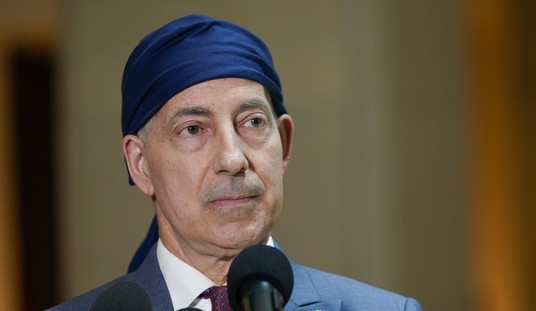A clue to the source of the enormous destructive power of the Obama administration’s blunders in the Middle East is contained in Victor Hugo’s novel, Ninety Three. It contains a famous chapter describing the struggle to contain a five ton carronade that has broken loose from its mountings and was now veering around the hull, smashing everything before it. It is where we get the phrase “loose cannon”. Here is Hugo’s dramatic description.
At the moment when the fastenings gave way, the gunners were in the battery, some in groups, others scattered about, busied with the customary work among sailors getting ready for a signal for action. The carronade, hurled forward by the pitching of the vessel, made a gap in this crowd of men and crushed four at the first blow; then sliding back and shot out again as the ship rolled, it cut in two a fifth unfortunate, and knocked a piece of the battery against the larboard side with such force as to unship it. This caused the cry of distress just heard. All the men rushed to the companion-way. The gun-deck was vacated in a twinkling.
The enormous gun was left alone. It was given up to itself. It was its own master and master of the ship. It could do what it pleased. This whole crew, accustomed to laugh in time of battle, now trembled.
The same words, with some alterations, might be used to describe the terrible forces unleashed by the administration’s attempts at proxy warfare — “leading from behind” as it is called. It has set sects, countries and regional terror groups clashing against each other. While each was tethered the dangers they posed were relatively confined. Now, loose upon the region these monsters are being fed by enormous inputs of energy: the loose weaponry of Libya, the competing financial supports of Iran, Qatar and Saudi Arabia, and the occasional help of American and Western military airpower.
The key event, of course, was to set them free, in the manner of a sorcerer’s apprentice who has opened the gates of hell and discovered, a little belatedly, that it is easier to summon the devil than to send him away. Like the “loose cannon” of Hugo’s story, the forces unleashed by the errors or incompetence or bad luck of the administration are now smashing apart country after country, community after community, releasing arsenal after arsenal.
It is doubly ironic that Hugo’s sailors try at first to halt the rampaging cannon with bundles of overprinted money known as assignats, by throwing bales of them under its wheels to slow it down. The loose cannon shreds the assignats to confetti.
Assignats were paper money issued by the National Assembly in France from 1789 to 1796, during the French Revolution. The assignats were issued after the confiscation of church properties in 1790 because the government was bankrupt. The government thought that the financial problems could be solved by printing certificates representing the value of church properties. These church lands became known as biens nationaux (“national goods”). Assignats were used to successfully retire a significant portion of the national debt as they were accepted as legitimate payment by domestic and international creditors. Certain precautions not taken concerning their excessive reissue and comingling with general currency in circulation caused hyperinflation.
Originally meant as bonds, they evolved into a currency used as legal tender. As there was no control over the amount to be printed, the value of the assignats exceeded that of the confiscated properties. This caused massive hyperinflation. In the beginning of 1792, they had lost most of their nominal value. In 1796, the Directoire issued Mandats, a currency in the form of land warrants to replace the assignats, although these too quickly failed.
Who knows but that someone might try to stem the rot with boxcars of printed money today? A few billion here, a few billion there … more energy to the cannon.
The secret power of a loose cannon lies in that it sets up a destructive resonance. It has the power to tap external energies and store them within itself, so that each swing grows in amplitude until even the strongest structures are shaken.
In 1940 the Tacoma Narrows bridge destroyed itself through the effects of such a resonance only a few months after it was completed. Outwardly it seemed solid enough. “At the time of its construction (and its destruction), the bridge was the third longest suspension bridge in the world in terms of main span length, behind the Golden Gate Bridge and the George Washington Bridge.” But there was a hidden flaw.
Because planners expected fairly light traffic volumes, the bridge was designed with two lanes, and it was just 39 feet (12 m) wide. This was quite narrow, especially in comparison with its length. With only the 8 feet (2.4 m)-deep plate girders providing additional depth, the bridge’s roadway section was also shallow.
The decision to use such shallow and narrow girders proved to be the original Tacoma Narrows Bridge’s undoing. With such minimal girders, the deck of the bridge was insufficiently rigid and was easily moved about by winds; from the start, the bridge became infamous for its movement. A mild to moderate wind could cause alternate halves of the center span to visibly rise and fall several feet over four- to five-second intervals. This flexibility was experienced by the builders and workmen during construction, which led some of the workers to christen the bridge “Galloping Gertie.” The nickname soon stuck, and even the public (when the toll-paid traffic started) felt these motions on the day that the bridge opened on July 1, 1940….
The bridge’s design added up the force of each gust of wind until it literally shook itself to pieces. About all that can be said about the bridge’s design today is that it seemed like a good idea at the time. The same fate may overtake the administration’s “leading from behind strategy”. What a clever scheme it seemed. A little Muslim Brotherhood here, a little al-Qaeda there, some Hezbollah thrown in on the side. Add hunger and chemical weapons, and voila! What could go wrong?
Where was the first tremor in the administration’s foreign policy architecture felt? What caused the fatal resonance? Ah, I know. It was a YouTube video, like the one below, only made in LA.
[jwplayer config=”pjmedia_richardfernandez” mediaid=”30025″]
Did you know that you can purchase some of these books and pamphlets by Richard Fernandez and share them with you friends? They will receive a link in their email and it will automatically give them access to a Kindle reader on their smartphone, computer or even as a web-readable document.
Rebranding Christianity for $3.99
The Three Conjectures at Amazon Kindle for $1.99
Storming the Castle at Amazon Kindle for $3.99









Join the conversation as a VIP Member